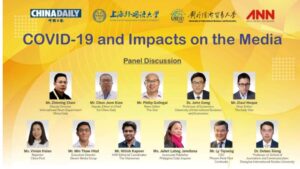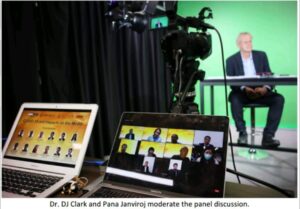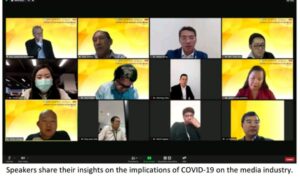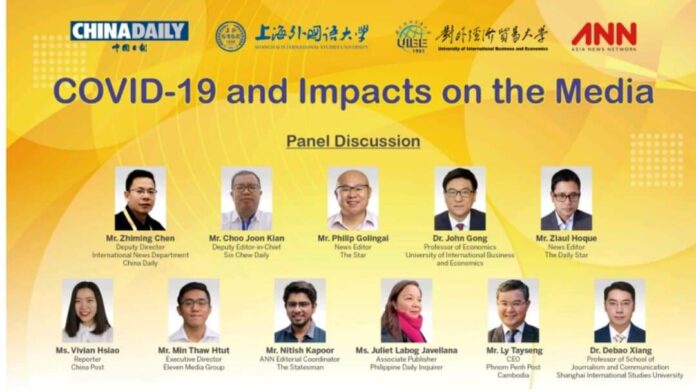Daily Gathers Media Leaders and Experts
To Discuss Reporting and Operations Strategies Amid the Pandemic
HONG KONG, Dec. 23, 2020 – Co-organized by China Daily, University of International Business and Economics, Shanghai International Studies University and Asia News Network, a panel discussion session themed “COVID-19 and Impacts on the Media” was held virtually on
Wednesday, December 23, 2020. Media leaders and experts joined the event online and discussed how reporting strategies and operations of the media have changed amid the COVID-19 pandemic.

Mr. Zhou Shuchun, Standing Committee member of the CPPCC National Committee and Publisher and Editor-in-Chief of China Daily, delivered the welcoming remarks. He said Chinese media colleagues have braved hardship and danger to record heart warming battles to tell the story of China’s fight against the pandemic, which boosted the morale of frontline warriors.
Later, Dr. John Gong, Professor of Economics, University of International Business and Economics; and Dr. Debao Xiang, Professor of School of Journalism and Communication, Shanghai International Studies University; shared their insights on the topic.
John Gong pointed out that the model of the media is changing. “Now people are more and more receiving messages through relays of information. What this difference makes is that, in order for the message to be relayed, there is a tendency for the message to go extreme. You’re moving into a world where you have those short snackable video clips kinds of product that people tend to use or like to watch. There’s no difference between fact and opinion-editorial. It is now even more difficult for readers to get information that is objective, fact-based.
Traditional media need to tighten their seatbelt and stick to what they are doing. If you have to sacrifice your journalistic standard for traffic volume, this is deplorable. The government needs to take actions. I think we have quite a strong government here in China that looks after this disinformation and misinformation,” he said.Debao Xiang pointed out that the pandemic’s impact on the industry is both negative and positive. “There is a decrease in the average media budget due to the coronavirus. Around 35,000 journalists in the US have been laid off and faced pay cuts amid the pandemic. This is not only influenced by COVID-19 but also the impact of the new technologies. But audience trust for journalists has increased …this is a good phenomenon for the journalism industry,” he said.
Insight Spotlight was followed by a panel discussion which was moderated by Mr. Pana Janviroj, Executive Director, Asia News Network; and Dr. DJ Clark, Multimedia Director, China Daily Asia Pacific. Prominent leaders from media companies and experts joined the panel discussion. They were: Mr. Zhiming Chen, Deputy Director of International News Department, China Daily; Mr. Choo Joon Kian, Deputy Editor in Chief, Sin Chew Daily; Mr. Philip Golingai, News Editor, The Star; Mr. Ziaul Hoque, News Editor, The Daily Star; Ms. Vivian Hsiao, Reporter, China Post; Mr. Min Thaw Htut, Executive Director, Eleven Media Group; Mr. Nitish Kapoor, ANN Editorial Coordinator, The Statesman; Ms. Juliet Labog-Javellana, Associate Publisher, Philippine Daily Inquirer; and Mr. Ly Tayseng, CEO, Phnom Penh Post, Cambodia.
They examined the implications of COVID-19 on the media industry. They discussed the future development of the media industry.
Pana Janviroj pointed out that many Asian media appear to be weathering the storms better than expected. But more importantly there is a consensus from bottom to top of the newsrooms, despite the dwindling resources and advertising revenue plunges, the relentless determination to do their jobs. “Those are to bring accurate reportings to readers and keep them well informed. The reporters are determined to do their jobs because readers and public at large appreciate their works. The Covid-19 era has endowed long awaited public appreciation of mainstream national media and journalism,” he said. Zhiming Chen highlighted that technology has played a key role to contain the 2020 virus. “As a news organization with global reach, China Daily is fortunate to have offices and reporters worldwide. This means, during critical moments in COVID-19 coverage, we have nose, eyes, ears on spot. This kind of local presence was invaluable for us,” he said hoo Joon Kian said Sin Chew Daily has not laid off or had pay cuts for anyone. The company has officially launched a membership scheme. He said that the number of members has increased to 240,000 and their e-papers have increased by 5 percent. The company plans to set up a paywall on hoo Joon Kian said Sin Chew Daily has not laid off or had pay cuts for anyone. The company has officially launched a membership scheme. He said that the number of members has increased to 240,000 and their e-papers have increased by 5 percent. The company plans to set up a paywall on Apple next year.
Philip Golingai said, “For me, with the retrenchment in most of the media organizations in Malaysia and also downsizing and some closures, having at least three to five news organizations is very promising for us. Roughly, that’s the situation for us.”
Ziaul Hoque said the COVID-19’s impact has been unsettling. “Our revenue went down two-thirds. There have been job cuts but they are not related to the pandemic. For workload, we have to adapt to these situations because it is the demand of the time. I think it’s a positive thing, in a sense that what we had to do, it expedited the process (to digitalization). We had to remodel business models,” he said. Vivian Hsiao said she saw a bump in the number of readers in the beginning. “When covering the COVID-19 pandemic, our readers really needed to know what’s going on. I think the responsibility of the media increased greatly this year, but we have to be careful in covering the pandemic and provide accurate information because we wanted to give our readers the current information. But we also wanted to avoid creating unnecessary panic among them as well,” she said.Min Thaw Htut said revenues from print advertising have declined. But that decline has been covered by digital investments. “Even though our core content is news, we have also diversified our content. The main lesson I have learnt is that we have to remain trustworthy, reliable and independent to do our main core functions. The other thing that we have to be mindful about is that the attention for eyeballs is very competitive. How do we survive this? It’s by creating good quality news,” he said. Nitish Kapoor said revenue was going down at the start of the pandemic. “But with an increase in internet users, we have gained revenue. Eventually, we’ll get long-term benefits for sure. It will surely come back to us,” she said. Juliet Labog-Javellana pointed out that one of the positive impacts of COVID-19 for the media is it provided the impetus to accelerate digital transformation and innovation. “So what the Inquirer did was to move quickly to different platforms like we hosted more than a dozen webinars; print journalists went into podcast….we published newsletters. Because most of our staff are working from home so maybe the big challenge during this pandemic is that media’s access to government officials has been limited because there are no face-to-face press conferences. Officials can mute you online. There’s no opportunity to grill officials. The Inquirer had to leverage our credibility to counter the ‘disinfodemic’ about COVID-19 which posed a danger to people’s lives,” she said. Ly Tayseng said, “This year, we didn’t have to retrench staff. This year, our advertising for printed media was reduced by 30 percent, but our subscription number has remained the same. Our digital revenue is increasing, but it is not significant. If the advertising revenue keeps dropping, I think there may be an impact for next year.”
About China Daily Founded in 1981, China Daily covers 33 million readers and users worldwide through diversified platforms, including newspapers, websites, and mobiles and social media. The number of China Daily’s followers has now reached 55 million on Weibo, 9.5 million on the WeChat Blog platform, 99 million on Facebook and another 4.39 million on Twitter.
About China Daily Asia Leadership Roundtable The China Daily Asia Leadership Roundtable is a by-invitation network of movers and shakers in Asia, providing platforms for focused dialogue, issue investigation and possible collective action on strategic issues relating to Asia’s economic, business and social development. Our aim is to enhance communication and increase mutual
understanding between China, Asian and Western countries. Roundtable events are held in major cities across
Asia.
Thank you for visiting my site and reading my article. Please follow my other social media accounts and read my column “Don’t Miss This” at The Rizal Weekly Post Www.facebook.com/HomeschoolWorld Www.instagram.com/HomeschoolingiscoolWww.twitter.com/Armipazpineda Www.facebook.com/Mimiworld.net Www.facebook.com/Homeiskool.com Www.facebook.com/Kawaiibeautyandlifestyle.com Www.facebook.com/Hometowngoodiesandservices Armipazpineda@gmail.com Livestream Channel @UPLive @Armi Livestream Channel @Facecast @PCTC_Ms.A YT channel: https://www.youtube.com/channel/UCAEszY-nm4XIPSphcppyilw















